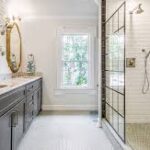Thermal insulation of the facade of a house is an integral part of the construction process, which is necessary to achieve comfortable living, including seasonal living. Modern building materials make it possible to insulate external walls at any time of the year and, if installed correctly, have a long service life.
Do-it-yourself home insulation
The walls of old apartment buildings are often susceptible to dampness, mold, and condensation. This is especially true for panel buildings. The insulation was embedded in reinforced concrete slabs in such buildings several decades ago. Therefore, an unprotected surface quickly freezes. Being at home is uncomfortable – the heat does not stay in the room for long. Similar problems exist in new houses if the construction technology has been violated. home insulation sydney from the outside allows you to reduce the air humidity level in the room to regular and obtain a favorable microclimate in the apartment.
Popular materials
Temperatures, humidity levels, and other parameters differ significantly outside and inside houses. Accordingly, it is necessary to understand the significant difference if we are talking about insulating walls from the inside or outside. But in general, it should be noted that the same materials are used in both cases.
When choosing the most suitable option, it is recommended to pay attention to the following characteristics:
- Resistance to shrinkage process.
- Simplicity of installation.
- Thermal insulation must withstand mechanical stress and not be damaged by harmful insects, mold, and bacteria.
- UV resistance. Guarantees a long life of the finish.
- Long service life. It allows you to reduce the repair and maintenance costs of the structure significantly.
Wooden buildings need good air exchange. Their walls must “breathe”. The finishing of the front side of the building can last a long time. The insulation must also be designed for an extended period of operation. You mustn’t have to remove the plaster and update the thermal insulation after a few years. Therefore, reliability and durability are essential qualities of the material used.
how to insulate the walls of apartments from the outside
In most cases, polystyrene foam or expanded polystyrene is used to insulate an apartment from the outside. When working on brick objects, it is recommended to use material 5 cm thick. For old panel houses – 10 cm. Using another type of thermal insulation is acceptable but impractical. Polystyrene foam is considered an inexpensive and highly effective variety. This building material is indispensable for cladding the front side of apartment buildings.
Insulation of the house facade from the outside
Regardless of the material used in construction, the building must be insulated. Insulation will help create a comfortable microclimate for those living in the house, reduce heating costs, and protect the building from premature destruction. Heat loss in winter is reduced, and residents are guaranteed the desired coolness in summer. Saving on heating is especially important in villages without a gas pipeline or other affordable resources.
The thickness and type of insulation directly depend on the construction technology. When constructing a frame house, mineral wool with a 150-200 mm thickness is usually used. Facades made of aerated concrete, for example, are not recommended to be supplemented with foam plastic. These are just some of the features – there are specific rules for using each type of insulation.
Materials for external thermal insulation of facades
The modern construction market offers the following types of insulation:
- Expanded polystyrene (foam plastic), polyurethane foam. High thermal insulation performance is achieved due to the unique structure of this type of building materials. Cells filled with gas are soldered together into blocks. Such slabs hardly absorb moisture, so they are often used when working with a plinth, basement, or foundation.
- Mineral wool, basalt, or glass wool. It is fireproof, does not interfere with air exchange, and is resistant to bacteria and fungi. The “disadvantage” is the excessive hygroscopicity of the fibers – they quickly gain moisture. The material is also subject to shrinkage.
- Expanded clay. Usually used on a facility under construction, forming a particular layer inside the built structure.
- Ecowool. Eighty percent comprises cellulose waste from paper production; the remaining 20 are additives preventing combustion and antiseptics. Fire resistance, environmental friendliness, and resistance to fungus are the main advantages of Ecowool. Disadvantages include a tendency to deformation and excessive hygroscopicity.
There are dozens more varieties of thermal insulation materials – a specific type is selected for each case. Natural raw materials (straw, linen boards, rice husks, etc.) are environmentally safe and relatively durable. However, the high cost and complexity of installation did not bring him popularity.
dew point and wall temperature chart
The primary function of any insulation is to move the dew point outside the building. In this case, the wall does not accumulate moisture, and dampness will not damage the structure. At the same time, heat loss is eliminated – the temperature in the room remains stable.
External wall insulation technology
First, the amount of building materials is calculated. To do this, determine the area of ?? the outer surface of the building. It would help if you multiplied the length by the height. From the result obtained, subtract the area of ?? the openings for existing doors and windows.
The whole process is divided into three stages:
- Removing dust, dirt, and stains from the surface being treated or wooden posts (in the case of a frame house). Elimination of cracks and chips.
- Preparation of glue for installation (if thermal insulation uses people and mineral wool components). The glue is available in dry form. The substance is mixed with water to the consistency indicated on the package. In frame houses, insulation is laid between the studs and covered with OSB boards, followed by installing the facade system without a binding component.
- Installation of insulation. Using a spatula, a layer of glue about 1 cm thick is applied to the foam or cotton wool. Then, the plates are pressed against the outer surface of the wall, and their position is leveled using a level. For more excellent durability of the structure, you can use special dowels. Ecowool and polyurethane foam are applied to the surface by spraying. Expanded clay is poured into the voids between the supporting structure and the facing brick.
This post was created with our nice and easy submission form. Create your post!



Comments
0 comments